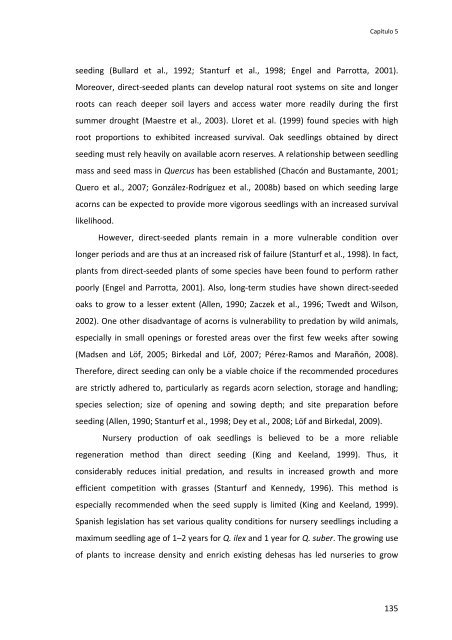Establecimiento de cuatro especies de Quercus en el sur de la ...
Establecimiento de cuatro especies de Quercus en el sur de la ...
Establecimiento de cuatro especies de Quercus en el sur de la ...
You also want an ePaper? Increase the reach of your titles
YUMPU automatically turns print PDFs into web optimized ePapers that Google loves.
Capítulo 5<br />
seeding (Bul<strong>la</strong>rd et al., 1992; Stanturf et al., 1998; Eng<strong>el</strong> and Parrotta, 2001).<br />
Moreover, direct‐see<strong>de</strong>d p<strong>la</strong>nts can <strong>de</strong>v<strong>el</strong>op natural root systems on site and longer<br />
roots can reach <strong>de</strong>eper soil <strong>la</strong>yers and access water more readily during the first<br />
summer drought (Maestre et al., 2003). Lloret et al. (1999) found species with high<br />
root proportions to exhibited increased <strong>sur</strong>vival. Oak seedlings obtained by direct<br />
seeding must r<strong>el</strong>y heavily on avai<strong>la</strong>ble acorn reserves. A r<strong>el</strong>ationship betwe<strong>en</strong> seedling<br />
mass and seed mass in <strong>Quercus</strong> has be<strong>en</strong> established (Chacón and Bustamante, 2001;<br />
Quero et al., 2007; González‐Rodríguez et al., 2008b) based on which seeding <strong>la</strong>rge<br />
acorns can be expected to provi<strong>de</strong> more vigorous seedlings with an increased <strong>sur</strong>vival<br />
lik<strong>el</strong>ihood.<br />
However, direct‐see<strong>de</strong>d p<strong>la</strong>nts remain in a more vulnerable condition over<br />
longer periods and are thus at an increased risk of failure (Stanturf et al., 1998). In fact,<br />
p<strong>la</strong>nts from direct‐see<strong>de</strong>d p<strong>la</strong>nts of some species have be<strong>en</strong> found to perform rather<br />
poorly (Eng<strong>el</strong> and Parrotta, 2001). Also, long‐term studies have shown direct‐see<strong>de</strong>d<br />
oaks to grow to a lesser ext<strong>en</strong>t (All<strong>en</strong>, 1990; Zaczek et al., 1996; Twedt and Wilson,<br />
2002). One other disadvantage of acorns is vulnerability to predation by wild animals,<br />
especially in small op<strong>en</strong>ings or forested areas over the first few weeks after sowing<br />
(Mads<strong>en</strong> and Löf, 2005; Birkedal and Löf, 2007; Pérez‐Ramos and Marañón, 2008).<br />
Therefore, direct seeding can only be a viable choice if the recomm<strong>en</strong><strong>de</strong>d procedures<br />
are strictly adhered to, particu<strong>la</strong>rly as regards acorn s<strong>el</strong>ection, storage and handling;<br />
species s<strong>el</strong>ection; size of op<strong>en</strong>ing and sowing <strong>de</strong>pth; and site preparation before<br />
seeding (All<strong>en</strong>, 1990; Stanturf et al., 1998; Dey et al., 2008; Löf and Birkedal, 2009).<br />
Nursery production of oak seedlings is b<strong>el</strong>ieved to be a more r<strong>el</strong>iable<br />
reg<strong>en</strong>eration method than direct seeding (King and Ke<strong>el</strong>and, 1999). Thus, it<br />
consi<strong>de</strong>rably reduces initial predation, and results in increased growth and more<br />
effici<strong>en</strong>t competition with grasses (Stanturf and K<strong>en</strong>nedy, 1996). This method is<br />
especially recomm<strong>en</strong><strong>de</strong>d wh<strong>en</strong> the seed supply is limited (King and Ke<strong>el</strong>and, 1999).<br />
Spanish legis<strong>la</strong>tion has set various quality conditions for nursery seedlings including a<br />
maximum seedling age of 1–2 years for Q. ilex and 1 year for Q. suber. The growing use<br />
of p<strong>la</strong>nts to increase <strong>de</strong>nsity and <strong>en</strong>rich existing <strong>de</strong>hesas has led nurseries to grow<br />
135

















